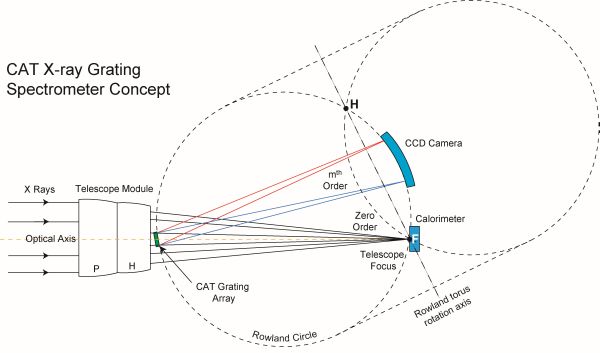Grating spectrometers for x-ray astronomy usually consist of an x-ray telescope (grazing incidence mirrors – i.e. the x-ray “lens” – that focus light from infinity onto an imaging detector in the telescope focal plane), an objective grating array just downstream of the telescope mirrors, and a dedicated detector readout array that collects the x-ray spectra generated by the gratings. The primary goal of the spectrometer optical design is to maximize the spectral resolving power R over the wavelength band of interest.
Since the invention of the Critical-Angle Transmission (CAT) grating we have developed and refined several new x-ray grating spectrometer (XGS) optical designs, based on existing transmission and reflection grating spectrometers, in collaboration with others at MKI. The designs all take advantage of the blazing property of CAT gratings, the so-called sub-aperturing technique to narrow the telescope point-spread function (PSF), and a tilted Rowland torus design. A CAT-XGS has the added advantage that it is transparent for high-energy x rays, which can then be collected by a microcalorimeter at the telescope focus to perform high-energy imaging spectroscopy simultaneously with CAT grating-based soft x-ray spectroscopy.

Schematic of CAT-XGS. (a) Optical design (b) Flight mirror assembly, 4 subsectors covered with CAT grating array (c) array structure populated with grating facets (d) grating facet (frame + membrane)
Ray-tracing simulations (done by John E. Davis, MKI) of telescopes with realistic contributions from different telescope mirror PSF error terms showed that a CAT-XGS can provide R = 3000-5000, depending on the details of the design and the telescope PSF. A CAT-XGS was first proposed for the Constellation-X mission, which later merged into the International X-ray Observatory (IXO). Since the cancellation of IXO several new x-ray mission concepts with a CAT-XGS instrument have been proposed, such as
AEGIS – an Astrophysics Experiment for Grating and Imaging Spectroscopy
AXSIO – the Advanced X-ray Spectroscopic Imaging Observatory
SMART-X – Square Meter, Arc-second Resolution X-ray Telescope
Arcus – The X-ray Grating Spectrometer Explorer (currently undergoing Phase A concept study)
Lynx – X-ray Observatory Mission Concept for 2020 Astrophysics Decadal Survey.
A CAT-XGS was also part of the Gen-X vision mission study.
Extensive details about the science case for a CAT-XGS, performance predictions, comparisons with existing missions, and response files can be found here. More recent ray-trace simulations by H. Moritz Günther can be found here (Arcus) and here (Lynx).
